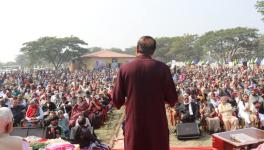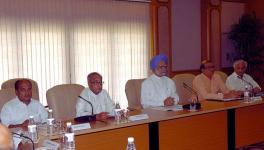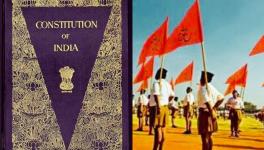Towards BJP’s Hindutva Lite Template
File Photo.
Kitney aadmi thhe—how many were there?
A meme based on this famous monologue from the highly successful film, Sholay (Embers), from the early seventies, started trending when “David” Kejriwal, leader of the Aam Aadmi Party (AAP), defeated “Goliath” Bharatiya Janata Party (BJP) in Delhi’s recent Assembly elections.
No doubt this election’s result has put paid to the efforts of Home Minister Amit Shah to retain his image as “Chanakya” of Indian politics, at least for now. The result is despite BJP’s desperate attempts to win Delhi, as part of which pulled chief ministers, former chief ministers, cabinet ministers and more than 240 Members of Parliament to campaign in the city. Blame it on the high stakes battle that allegations surfaced that they had distributed cash and liquor ahead of the polls.
The result is for everyone to see.
The most toxic electoral campaign, perhaps ever, in which leaders of the ruling dispensation even provoked violence through their hate speeches, did not work. The BJP’s seat tally rose by merely five and a bloody nose.
The BJP has been losing state elections and it has been compelled to ally with regional formations, some of whom had fought on an anti-BJP platform (as happened in Haryana). All this is happening after it secured a second consecutive term at the Centre less than nine months ago with a higher vote-share and seat-count.
A pan-India mass resistance has emerged to counter the Centre’s highly contentious CAA-NRC-NPR (Citizenship Amendment Bill, National Register of Citizens, National Population Register) triad that shows no signs of abating. The movement has had reverberations abroad, which has definitely put the BJP on the defensive. Prior to adopting these contentious policies, the BJP had got a law passed in Parliament that makes triple talaq a criminal offence. It has also dissolved the statehood of Jammu and Kashmir. Neither step had faced much resistance.
Then the BJP had got the chance to exult over the favourable judgement in the Ayodhya case. These circumstances emboldened the party to get its government to change the basic structure of Constitution, which is what the CAA does. Of course, in the BJP’s world view, the CAA and NRC are nothing but wedges to divide India’s two biggest communities. In its contemplation, these moves would face no resistance once again. But reality turned out exactly the opposite.
Had the BJP won the Delhi election, it would have got a rationale for its divisive rhetoric. Its leaders and supporters have been name-calling the Shaheen Bagh protesters ‘Pakistan-supporters’ and ‘terrorist-sympathisers’. A victory would have had the party project the public’s endorsement of its policies and this is the message it would have carried to Bihar and Bengal, where Assembly elections are due.
To be fair, the electoral loss does not imply that the BJP’s strategic goal to Hinduise voters has borne no fruit at all. Their vote share has climbed 8% and their chief adversary, the Congress party, has been routed. Winning elections is important to the BJP, but its agenda stretches beyond elections, as many have pointed out and the leading public intellectual Pratap Bhanu Mehta recently said. This agenda is to culturally transform India. “Elections will come and go. But the BJP will measure its success by a longer-term cultural transformation. The goal of this cultural transformation is two-fold. It is to assert Hindu majoritarianism. But it is also to transform Hinduism from a variety of religious practices into a consolidated ethnic identity,” Mehta wrote recently.
The Rashtriya Swayamsevak Sangh or RSS, patron of the Sangh Parivar (which includes the BJP) had even supported the Congress party during elections in 1984 following the assassination of prime minister Indira Gandhi. The BJP had won only two seats in that Lok Sabha poll, but barely a month before that election veteran RSS ideologue Nanaji Deshmukh had written in the Hindi magazine, Pratipaksh, that his followers should “bless and cooperate” with Rajiv Gandhi, Indira’s son and future prime minister.
Therefore, it was not sanyog or coincidence that the BJP’s Delhi campaign was a divisive and polarising prayog or experiment. This is the BJP’s template and it will be emulated in other elections.
Considering the long history of sectarian and communal conflicts in Bihar and Bengal, the toxicity the BJP would likely inject into the election campaigns in both states would damage the social fabric, besides raising the risk of bloodshed.
Some analysts believe that AAP’s electoral victory is a rejection of hate politics sponsored by the BJP. This is perfect analysis for those with a limited understanding of politics: hate politics viewed in a wider framework of the Sangh-BJP’s tactics tells an altogether different story.
A roughly 8% swing in votes since the last elections is not a small shift in BJP’s favour and it was an outcome of only the most vitriolic campaign it has led in recent times. Never before had there been direct provocations to violent acts against the ‘Other’ from cabinet ministers and party leaders alike. Never before had elected MPs stigmatised minorities and provoked majoritarian sentiment with openly communal rhetoric.
The poisonous rhetoric was deployed on a large scale in an organised, planned and methodical way. The argument, stripped down to its basic element, was that “Hindus are in danger”—do not ask how or why 85% of the population can imagine a threat from a minority of 15%.
Social media—WhatsApp, Facebook—spread the sectarian propaganda, furthering the BJP’s aim to weaponise falsehoods. With a pliant media, a compromised bureaucracy and key institutions failing to uphold constitutional values, divisive rhetoric had a field day in the Delhi campaign.
As this scenario unfolded, was it not incumbent on any political formation—especially one with the wherewithal and experience of being in power, and which does not subscribe to communalism as a political tool—to take hate-mongers to task and ensure legal action against them? AAP miserably failed in this, for it decided not to engage in these debates at all. It found it a worthwhile strategy to keep quiet and merely focus itself on its ‘work’.
When the BJP and its leaders were openly spouting communal venom and bodies such as election commission were content to ban the miscreants for limited durations, ignoring stringent laws to nip such acts in the bud—there was nobody around to pressurise the election commission to be more professional.
A section of media has lauded Kejriwal for not falling into the Hindu-Muslim trap of the Modi-Shah combine. No doubt, if politics is to be reduced merely to vote-gathering while ignoring raging national controversies, then it was a smart move. But a conscious attempt is on to the dismantle the edifice of Constitution. Silence in the face of this unfolding debate is highly questionable.
Disturbingly, for long Kejriwal took no stand on Shaheen Bagh, but when cornered in a debate he questioned Shah’s inability to clear the road of protesters. “If Delhi Police was under the state government’s jurisdiction, it would have opened the Shaheen Bagh road in two hours,” he said. Thus, inadvertently or not, he pandered to the majoritarian prejudice against minorities.
Kejriwal’s sudden metamorphosis into a Hanuman bhakt, by reciting the Hanuman Chalisa and visiting a Hanuman temple also basically caters to similar sentiments. The question arises whether Kejriwal’s attitude is a recent phenomenon or were always part of his persona. Remember, he supported abrogation of Article 370; and when AAP’s chances of an alliance with Congress fizzled out prior to a previous election, he had then claimed in a press conference that according to his party’s surveys, “no Hindu will vote for Congress anyway. Muslims were initially confused, but now they will vote for us.” The claim was clearly construed to polarise voters.
Analysts have noted attempts to reinforce Kejriwal’s identity as a Hindu. On June 4, twelve days after the Lok Sabha results, Kejriwal retweeted a picture, “Swaminarayan Bhagwan Ka Abhishek’ and four other photos shared by AAP’s official Twitter handle. He tweeted Eid greetings too—“Aap sabhi ko Eid Mubarak”—but with no pictures.
Reports point out that he welcomed the court’s verdict in the Kathua gang-rape and murder but was also silent on the Pehlu Khan lynching case—a deafening silence considering the family has not got justice. In the latter instance, only his deputy Manish Sisodia tweeted, Kejriwal did not weigh into the discussion.
AAP under Kejriwal has won the elections but as columnist Swati Chaturvedi has rightly said, “Anyone who says the Delhi result turns down the dial on bigotry is delusional.”
The author is an independent journalist. The views are personal.
Get the latest reports & analysis with people's perspective on Protests, movements & deep analytical videos, discussions of the current affairs in your Telegram app. Subscribe to NewsClick's Telegram channel & get Real-Time updates on stories, as they get published on our website.























